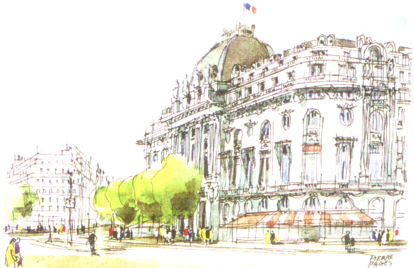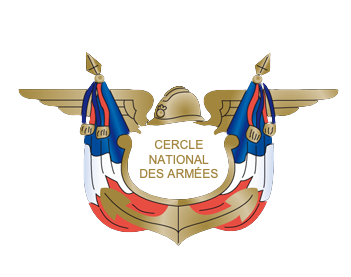The circle
This building on Place Saint-Augustin is the work of the chief architect of the national palaces, Charles Lemaresquier, a member of the Institute. We owe the statues surmounting the columns of the facade to sculptors also from the Institute:
Injalbert for the “Turc”, François Sicard for the “Poilu”, Jean Boucher for the “Marin” and Paul Landowsky for the “Cuirassier”. This beautiful building houses a hotel with 89 rooms, dining rooms, an air-conditioned bar, a prestigious bistro, a fitness room, a library, reception rooms that can accommodate up to 1,000 people for cocktails and 500 covers for meals. , a conference room with 250 seats and a renowned weapons room. Located in the heart of Paris, the Cercle National des Armées welcomes active, retired or reserve officers, category “A” or equivalent officials of the Ministry of Defense, as well as holders of the Legion of Honor, the auditors and former auditors of the Institute for Advanced Studies in National Defense (IHEDN) or the Center for Advanced Studies in Armament (CHEAr) as well as their families and their guests.
The history
The Cercle National des Armées finds its origins in a presidential decree of February 5, 1887 and in a law of April 16, 1924 authorizing its establishment on the grip of the barracks of the Nursery.
It was built, from 1925 to 1927, on land liberated by the destruction of part of the barracks of the Nursery, including its facade. The President of the Republic Gaston Doumergue inaugurated it in 1928.
The National Circle of Land and Sea Armies, which was until then avenue de l’Opéra, thus settled on Saint-Augustin square.
The neo-classical building is the work of Charles Henri-Camille Lemaresquier, chief architect of the national palaces, born in Sète on October 16, 1870 and died in Paris on January 6, 1972 (he is buried in the Sète marine cemetery ) .
He is the son of Louis Lemaresquier, famous poster designer of the 19th century. Father of Christmas Lemaresquier, architect, who will assist him then succeed him as workshop boss at the National School of Fine Arts in Paris and join him at the Academy of Fine Arts of the Institut de France. He is also the stepfather of Michel Debré and the maternal grandfather of Jean-Louis Debré and Bernard Debré.
Pupil, friend and successor to the National Superior School of Fine Arts in Paris, of the first Grand Prix de Rome Victor Laloux, his works are rare:
The Headquarters of Félix Potin in Paris, 1910, No. 51 rue Réaumur;
The Hotel and the Imprimerie des Journals Officiel, in Paris, rue Saint-Saëns;
The Palais Berlitz in Paris, a block between the boulevard des Capucines, the rue Louis le Grand, the rue de la Michodière and the rue de Hanovre;

- The Havas agency hotel in Paris;
- The Veterinary School in Toulouse;
- The Sainte-Anne hospital in Paris;
- The School of Marine Mechanics at Saint-Mandrier-sur-Mer;
- The Maritime Gendarmerie in Toulon.
Military symbols are found on the carved decorations. Thus, the remarkable statues surmounting the columns of the facade are the work of the sculptors, members of the institute: Jean-Antoine Injalbert for the “Turco”, François-Léon Sicard for the “Poilu”, Jean Boucher for the “Marin “And Paul Landowsky for the” Cuirassier”. On the side façade located at 35 rue Laborde, you can admire warrior attributes (helmets, spades, standards) on either side of the window on the 1st floor, and a chariot on horseback above the window on the second .
rules of procedure
The Cercle National des Armées is a public administrative establishment with a social and cultural vocation endowed with legal personality and which responds to a double vocation:
- Welcome active, retired or honorary officers. It is a place of meeting and exchange which contributes to the sustainability of the traditions, the greatness and the prestige of the state of officer.
- Welcome the high authorities of the Ministry of the Armed Forces, as well as their civil and military hosts, French and foreign.
